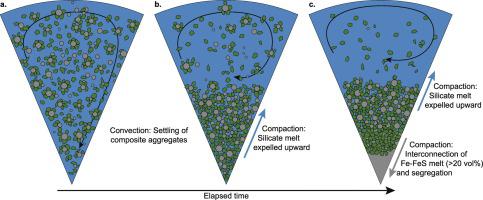Physics of the Earth and Planetary Interiors ( IF 2.3 ) Pub Date : 2021-07-15 , DOI: 10.1016/j.pepi.2021.106771 A. Néri 1 , M. Monnereau 1 , J. Guignard 1 , M. Bystricky 1 , C. Tenailleau 2 , B. Duployer 2 , M.J. Toplis 1 , G. Quitté 1

|
The textures of solid and molten metal in the presence of varying fractions of silicate melt at high temperature have been investigated to shed light on differentiation processes occurring in magma oceans formed on rocky bodies of the early solar system. Analogue experiments have been performed in a three-phase system (composed of coexisting metal, forsterite and silicate melt) in both static (1 GPa, 1723 K) and dynamic (i.e. agitated, at 1 bar, 1713 K and 1743 K) conditions. Micro-textures were analyzed with SEM and EBSD techniques, while meso-textures of the metallic phase were analyzed using ex-situ 3D microtomography.
Although all samples exhibit the same micro-scale organization consistent with the minimization of local interfacial energies, their meso-scale textures differ significantly. Static conditions produce metal grains that have shapes close to spherical, corresponding to the state predicted by the grain-scale minimization of interfacial energies. In contrast, under dynamic conditions and in the presence of high silicate melt fractions (≥50 vol%), molten metal coalesces to form pools with sizes that are several orders of magnitude larger than those predicted by grain growth mechanisms. Furthermore, in agreement with expectations based upon an interfacial energy budget, images show that nickel grains, whether solid or molten, do not occur surrounded entirely by silicate melt, but rather in contact with both forsterite crystals and silicate melt, leading to the formation of composite aggregates.
Assuming that a magma ocean has less than 50 vol% of crystals (the upper limit that permits convective motion), thermodynamic calculations indicate that at the necessary temperatures, the metallic subsystem (Fe-Ni-S) of the planetesimal is entirely molten and the silicate residue is only composed of olivine. Convective motions in such a body will drive agitation, promoting the formation of composite aggregates of olivine and molten iron-sulfide, their initial coalescence and subsequent fragmentation. In detail, these composite aggregates have a reduced density contrast with the surrounding silicate melt that reduces their settling velocities compared to pure metal. They also entrain olivine during the downward migration of iron-sulfide pools. Olivine grains concentrate at the surface of the metallic pools, hindering coalescence between pools or with a pre-existing core. An alternative differentiation scenario for core formation is explored in which the simple compaction of partially molten mixtures in the basal non-convecting layer of the magma ocean expels the interstitial silicate melt upward, such that the local fraction of iron-sulfide increases by mass-balance, reaching its percolation threshold and allowing core formation. This process is not only limited to early accreted planetesimals but may also occur in terrestrial bodies.
中文翻译:

对流岩浆海洋中金属相的结构演化:3D 显微断层扫描研究
已经研究了在高温下存在不同比例的硅酸盐熔体时固体和熔融金属的质地,以揭示早期太阳系岩石体上形成的岩浆海洋中发生的分化过程。在静态 (1 GPa, 1723 K) 和动态 (即搅拌, 1 bar, 1713 K 和 1743 K) 条件下,在三相系统(由共存的金属、镁橄榄石和硅酸盐熔体组成)中进行了类似实验。使用 SEM 和 EBSD 技术分析微观纹理,而使用非原位 3D 显微断层扫描技术分析金属相的细观纹理。
尽管所有样品都表现出与局部界面能量最小化一致的相同微尺度组织,但它们的中尺度纹理显着不同。静态条件产生形状接近球形的金属晶粒,对应于通过界面能的晶粒尺度最小化预测的状态。相比之下,在动态条件下和存在高硅酸盐熔体分数 (≥50 vol%) 的情况下,熔融金属聚结形成尺寸比晶粒生长机制预测的尺寸大几个数量级的熔池。此外,与基于界面能量预算的预期一致,图像显示镍晶粒,无论是固体还是熔融状态,都不会完全被硅酸盐熔体包围,而是与镁橄榄石晶体和硅酸盐熔体接触,
假设岩浆海洋的晶体少于 50 vol%(允许对流运动的上限),热力学计算表明,在必要的温度下,小行星的金属子系统 (Fe-Ni-S) 完全熔化,并且硅酸盐残渣仅由橄榄石组成。这种物体中的对流运动将驱动搅拌,促进橄榄石和熔融硫化铁复合聚集体的形成、它们的初始聚结和随后的碎裂。详细地说,这些复合骨料与周围的硅酸盐熔体的密度对比降低,与纯金属相比,这降低了它们的沉降速度。它们还在硫化铁池向下迁移过程中夹带橄榄石。橄榄石颗粒集中在金属池的表面,阻碍池之间或与预先存在的核心的合并。探索了岩心形成的另一种分化方案,其中岩浆海洋基底非对流层中部分熔融混合物的简单压实将间隙硅酸盐熔体向上排出,从而使硫化铁的局部分数通过质量平衡增加,达到其渗透阈值并允许核心形成。这个过程不仅限于早期吸积的星子,也可能发生在地球天体中。这样,硫化铁的局部分数通过质量平衡增加,达到其渗透阈值并允许核心形成。这个过程不仅限于早期吸积的星子,也可能发生在地球天体中。这样,硫化铁的局部分数通过质量平衡增加,达到其渗透阈值并允许核心形成。这个过程不仅限于早期吸积的星子,也可能发生在地球天体中。


























 京公网安备 11010802027423号
京公网安备 11010802027423号